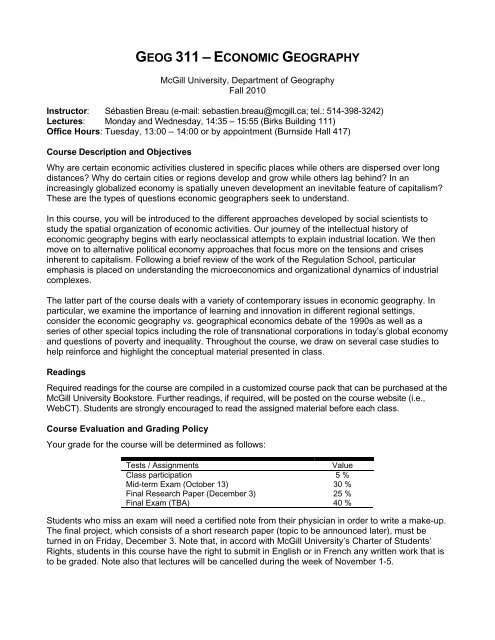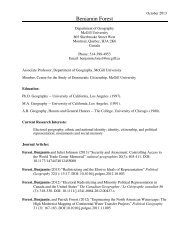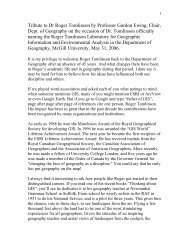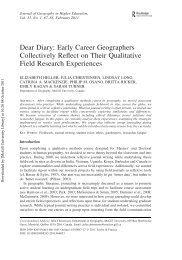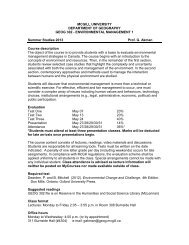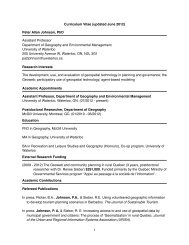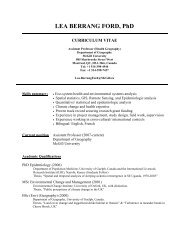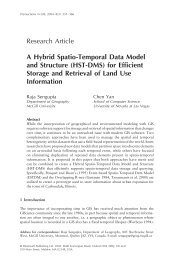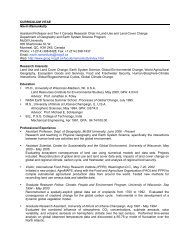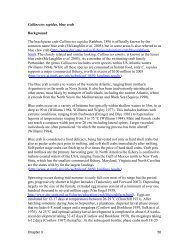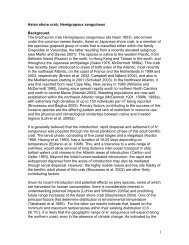GEOG 311 – E - Department of Geography, McGill University
GEOG 311 – E - Department of Geography, McGill University
GEOG 311 – E - Department of Geography, McGill University
Create successful ePaper yourself
Turn your PDF publications into a flip-book with our unique Google optimized e-Paper software.
Academic Integrity<strong>McGill</strong> <strong>University</strong> values academic integrity. Therefore all students must understand the meaning andconsequences <strong>of</strong> cheating, plagiarism and other academic <strong>of</strong>fences under the Code <strong>of</strong> StudentConduct and Disciplinary Procedures (see www.mcgill.ca/students/srr/honest/ for more information).Topic 1 – Setting the sceneCOURSE OUTLINE AND READING ASSIGNMENTSThe first week <strong>of</strong> lectures is designed to provide you with a general introduction to the course and its keythemes. Topics explored include how we think about economics in geographical terms (i.e. definitions <strong>of</strong>basic spatial concepts) and how economic geography, as a discipline, has evolved over time.Reading:Coe, N., Kelly, P. F., and Yeung, H. W. C. (2007). A Geographical Approach to theEconomy. In Economic <strong>Geography</strong>: A Contemporary Introduction. Blackwell Publishing,pp. 3-25.Sheppard, E. 2006. The economic geography project. In Economic <strong>Geography</strong>: Past,present and future, eds. S. Bagchi-Sen and H. Lawton Smith. New York: Routledge,pp.11-23.Topic 2 – Neoclassical approaches I: Homogeneous land surfaces and the search for generallawsHere we examine some <strong>of</strong> the earlier attempts at explaining the spatial organization <strong>of</strong> economicactivities. Particular attention is paid to the work <strong>of</strong> German location theorists (e.g. Weber, Christaller,Losch) and to the 1950s and 60s Regional Science movement. We explore how geometry and othertechniques borrowed from the physical sciences are used in the search for general laws characterizingthe structure <strong>of</strong> the ‘space-economy’.Readings:Isserman, A. 2001. Regional Science. In The International Encyclopedia<strong>of</strong> the Social and Behavioral Sciences, eds. N. J. Smelser and P. B.Baltes. Amsterdam and New York: Elsevier, pp.12930-12935.Dicken, P., and Lloyd, P. E. 1990. Location in Space: TheoreticalPerspectives in Economic <strong>Geography</strong>. New York: HarperCollins Publishers, pp.15-43, 83-92.Topic 3 – The need for alternative approachesRealizing that even the most sophisticated neoclassical models <strong>of</strong> equilibrium and optimization cannotaccount for the deeper and more complex socio-economic tensions inherent to capitalism, economicgeographers begin to search for alternative approaches to explain the location <strong>of</strong> economics activities.Here we draw on Marxist theory to present an outline <strong>of</strong> some <strong>of</strong> the defining elements <strong>of</strong> capitalism andexplore its uneven spatial development.Readings:Storper, M., and Walker, R. 1989. The Capitalist Imperative: Territory, Technology, andIndustrial Growth. Oxford: UK; New York, NY: Blackwell (chapter 2, pp.6-35).Edel, M. 1981. Capitalism, Accumulation and the Explanation <strong>of</strong> Urban Phenomena. InUrbanization and Urban Planning in Capitalist Society, eds. M. Dear and A. J. Scott.London and New York: Methuen, pp.19-44.
Topic 4 – Regulation theory and the transition from Fordism to post-FordismDuring the late 1970s and early 1980s, French Regulationists (e.g. Aglietta, Lipietz, Boyer) developed aconceptual framework to help characterize and explain the ‘macro-structures’ <strong>of</strong> capitalist economies andhow these change over time. This set <strong>of</strong> lectures takes a look at different historical periods <strong>of</strong> capitalistexpansion, paying particular attention to the contemporary transition from Fordism to post-Fordism andsome <strong>of</strong> its spatial expressions.Readings:Bryson, J., and Henry, N. 2001. The global production system: from Fordism to post-Fordism. In Human <strong>Geography</strong>: Issues for the 21st Century, eds. P. Daniels, M.Bradshaw, D. Shaw, and J. Sidaway. New York: Pearson Education, pp.342-372.Moulaert, F., and Swyngedouw, E. A. 1989. Survey 15 – A Regulation Approach to the<strong>Geography</strong> <strong>of</strong> Flexible Production Systems. Environment and Planning D - Society &Space, 7: 327-345.Topic 5 – Alternative approaches I: New Industrial Spaces?After the crisis <strong>of</strong> Fordism, a ‘new economy’ begins to take shape. Whether we call it post-Fordism, post-Industrialism, or the Information economy, at the heart <strong>of</strong> this ‘new economy’ is the notion <strong>of</strong> flexiblespecialization. Here, we take a close look at the micro-dynamics <strong>of</strong> the organization <strong>of</strong> production,processes <strong>of</strong> agglomeration and the formation <strong>of</strong> industrial complexes, all <strong>of</strong> which are captured in Scott’sNew Industrial Spaces.Readings:Scott, A. J. 1988. Flexible Production Systems and Regional-Development - the Rise <strong>of</strong>New Industrial Spaces in North-America and Western-Europe. International Journal <strong>of</strong>Urban and Regional Research, 12: 171-186.Scott, A. J. 1988. Metropolis: from the division <strong>of</strong> labor to urban form.Berkeley: <strong>University</strong> <strong>of</strong> California Press (chapters 3 and 4, pp.26-60).NB The mid-term is scheduled for the Wednesday, October 13.Topic 6 – Alternative approaches I (continued)To continue our exploration <strong>of</strong> new industrial spaces / industrial complexes, we examine various casestudies and introduce some elements <strong>of</strong> an initial critique <strong>of</strong> the concept.Readings:Saxenian, AnnaLee. 1994. Regional advantage: culture and competition in Silicon Valleyand Route 128. Cambridge, Mass.: Harvard <strong>University</strong> Press (chapter 2).Scott, A. J. 2002. A new map <strong>of</strong> Hollywood: The production and distribution <strong>of</strong> Americanmotion pictures. Regional Studies, 36(9): 957-75.Sforzi, F. 1989. The <strong>Geography</strong> <strong>of</strong> Industrial Districts in Italy. In Small Firms and IndustrialDistricts in Italy, eds. E. Goodman and J. Bamford. London: Routledge, pp.153-173.Topic 7 – Alternative approaches II: From industrial districts to innovative milieux and learningregionsIn time, economic geographers begin to voice concerns over the flexible specialization / new industrialspaces perspective arguing that the analytical framework it provides is perhaps too static as the realadvantages <strong>of</strong> flexible districts are dynamic. Hence, more recent or ‘up-to-date’ approaches focus on theinstitutional factors that are embedded within certain regions. Ideas <strong>of</strong> networks, cooperation, knowledge
flows, institutional thickness and untraded interdependencies are central here, as are evolutionaryconcepts.Readings:Storper, M. 1997. The Regional World. Guilford Press (Chapter 1: The Resurgence <strong>of</strong>Regional Economies, Ten Years Later).Morgan, K. 1997. The learning region: Institutions, innovation and regional renewal.Regional Studies, 31(5): 491-503.Gertler, M. 1997. The Invention <strong>of</strong> Regional Culture. In Geographies <strong>of</strong> Economies, eds.R. Lee and J. Wills. London; New York: Arnold, pp.47-58.Topic 8 – Untraded interdependencies and the economic geography <strong>of</strong> talentHere we review recent case studies <strong>of</strong> innovative milieux / learning regions in Europe and take a closerlook at the geography <strong>of</strong> talent and innovation in the U.S.Readings:Pinch, S., and Henry, N. 1999. Paul Krugman's geographical economics, industrialclustering and the British motor sport industry. Regional Studies, 33(9): 815-27.Florida, R. 2002. The economic geography <strong>of</strong> talent. Annals <strong>of</strong> the Association <strong>of</strong>American Geographers, 92(4): 743-55.Donegan, M., and Lowe, N. 2008. Inequality in the creative city: Is there still a place for"Old-Fashioned" institutions? Economic Development Quarterly, 22 (1): 46-62.Topic 9 – Neoclassical approaches II: New geographical economicsLong relegated to the status <strong>of</strong> a marginal topic within the discipline, mainstream economists are nowrediscovering the importance <strong>of</strong> space. These lectures explore two different approaches to the study <strong>of</strong>space in contemporary economics: (i) Krugman’s new economic geography, which stems from the newtrade / growth theory literature and (ii) Porter’s competitive advantage, a concept that has been widelyadopted by policy makers and applied in the regional context.Readings:Krugman, P. 1998. What's New About the New Economic <strong>Geography</strong>?Oxford Review <strong>of</strong> Economic Policy, 14: 7-17.Porter, M. 1998. Clusters and the new economics <strong>of</strong> competition. Harvard BusinessReview, 76(6): 77-90.Topic 10 – Special focus: Transnational Corporations (TNCs)TNCs play a pivotal role in today’s global economy. Here, we focus on the activities <strong>of</strong> TNCs and explorethe geography <strong>of</strong> global production networks.Readings:Dicken, P. 2007. Global Shift: Mapping the Changing Contours <strong>of</strong> the World Economy, 5 thedition, New York, NY: Guilford Press. Chapter 4 (pp.106-135).Coe, N. et al. 2004. ‘Globalizing’ regional development: a global production networksperspective. Transactions <strong>of</strong> the Institute <strong>of</strong> British Geographers, 29: 468-484Topic 11 – Special focus: Region Development Policy – A Canadian PerspectiveHaving reviewed the key theoretical approaches developed in the field <strong>of</strong> economic geography, we nowturn our attention to regional development policy as it has evolved in the Canadian context.
Readings:Savoie, D. J. 2003. Reviewing Canada’s Regional Development Efforts. A reportprepared for the Royal Commission on Renewing and Strengthening Our Place inCanada, Government <strong>of</strong> Newfoundland and Labrador.Topic 12 – Special focus: Inequality and geographySpatial inequalities are inevitable under capitalism. Here we consider various analyses <strong>of</strong> recent trends ininequality at the global scale and, within the North American context, across Canadian regions.Readings:Galbraith, J. K. 2002. A perfect crime: inequality in the age <strong>of</strong> globalization.Daedalus, 131(1): 11-25.Breau, S. and D. Rigby (2009). International trade and wage inequality in Canada.Journal <strong>of</strong> Economic <strong>Geography</strong>, doi:10.1093/jeg/lbp016.Some final thoughtsThe final lecture is dedicated to wrapping-up our discussion on inequality and some final words on futureresearch directions in economic geography.


